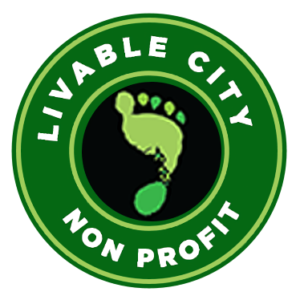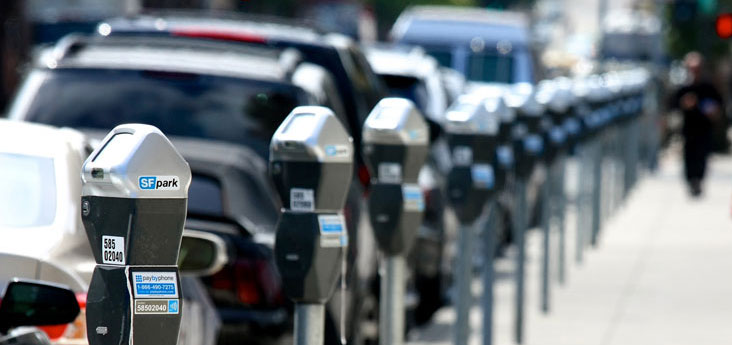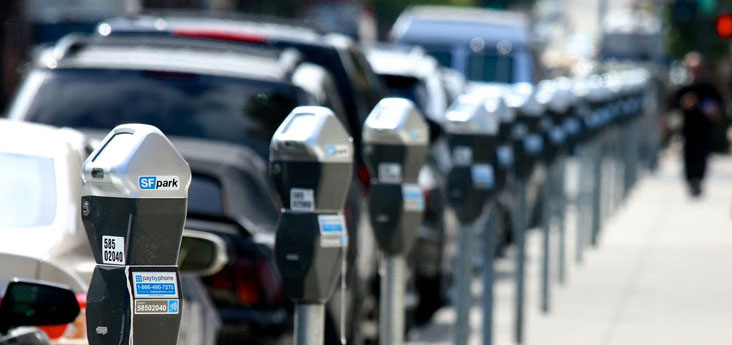One of the most effective ways to reduce traffic congestion and pollution, and encourage a shift to sustainable transportation modes, is through parking reform – smarter pricing and management of available parking, and reducing parking subsidies and requirements. Livable City’s parking reform strategy seeks to harness the power of markets and technology to further social, economic, and environmental goals.
We support pricing on-street parking to create available spaces at most times. Proper pricing reduces traffic congestion from cars cruising for parking, generates parking turnover that helps neighborhood businesses, and increases revenue from parking meters and permits. We support reinvesting some of these on-street parking revenues back into neighborhood walking, cycling, transit, streetscape, and greening projects.
Off-street parking requirements harm the environment by encouraging automobile traffic and pollution, and increase the cost of housing, goods, and services for San Francisco’s residents and businesses. Livable City successfully campaigned to eliminate off-street parking requirements citywide, ensure that parking costs are “unbundled” from the cost of buying or renting housing or commercial space, and restrict excessive parking and driveways where they do harm to pedestrians, cyclists, and transit.
Putting new thinking about parking into practice
| Old | New |
| Parking is a social good. | Parking is not an entitlement. |
| More parking is always better. | Too much parking can create problems. |
| Parking demand is fixed, regardless of price or transportation alternatives. | Parking demand is elastic, and depends on price and the availability of transportation alternatives. |
| Governments should establish minimum parking requirements. | Governments shouldn’t mandate parking, and should instead establish maximum parking allowances where they make sense. |
| Parking costs should be bundled into the cost of housing, goods, and services | Parking costs should be unbundled from the cost of housing, goods, and services. |
| Parking is a burden to government, and subsidies to parking will compete with other priorities for available funding. | Parking can be a source of revenue for government, and if priced correctly can fund other city priorities. |
| Parking should be priced to encourage full utilization. | Parking should be priced so as to create some available spaces at most times. |
| Cities shoud use time limits to increase parking availability and turnover. | Cities should use price to increase parking availability and turnover. |
Current Campaigns
- Unbundle non-residential parking from leases. Businesses will only pay for the parking they use, which will encourage more efficient use of parking and reduce costs for businesses that embrace sustainable transportation.
- reflect more of the cost of road maintenance in the price of street parking permits.
- Decrease the amount of office parking permitted the Downtown core.
- Create, or strengthen, sunset provisions for surface parking lots in transit-rich areas. Encouraging the conversion of surface parking lots to active uses creates opportunities for jobs and housing, and reduces blight in neighborhoods.
- Expand Downtown’s parking pricing requirements that favor short-stay parking over daily and monthly parking.
- Extend parking meter enforcement to evenings and Sundays.
- Create a local parking cash-out law, requiring employers that offer free parking to compensate employees who don’t park with an equal value in transit vouchers or cash.
- Restrict above-ground parking in new buildings in favor of underground parking.
- Restrict new surface parking lots in Neighborhood Commercial and Residential districts.
- Require that new structured parking be designed for easy conversion to non-parking uses.
- Reduce parking maximums in Rincon Hill and Transbay to be consistent with Downtown parking maximums.
- Prohibit new parking over water on Port property, and encourage phase-out of existing waterfront parking lots for public open space or joint development.
- Ensure that transportation impact fees for new developments capture the additional transportation impact of excess parking, and reduce fees for projects that reduce auto trips.
The SFpark Program
In 2011, San Francisco’s SFpark program started in several pilot neighborhoods around the City. The SFpark program includes many of the progressive parking reform ideas long championed by Livable City. Sensors in parking spaces on the street and in city-owned lots gather accurate information about how on-street parking is used, and how many spaces are available. The information gathered is used to adjust parking rates in response to demand, towards the goal of creating some available spaces at all times of day. Creating available spaces is a convenience to merchants and residents, and reduces traffic by eliminating cars cruising for parking spaces. The program has also installed ‘smart meters’ that make it easier for MTA to adjust rates up or down based on demand and to adjust time limits and hours of operation, and make it easier to pay for parking with credit cards, smart cards, and cash.
Adding new parking is costly, both in environmental and economic terms; SFpark will allow the city to much better manage existing parking for the benefit of residents and businesses.
SFpark’s pilot projects build on the findings of the San Francisco County Transportation Authority’s On-Street Parking Management and Pricing Study. The SFCTA study looked in depth at parking issues in four San Francisco neighborhoods – Cow Hollow, West Portal, Hayes Valley, and Bernal Heights. The study surveyed parking availability, parking turnover, and parking duration, and interviewed merchants and residents. Among the study’s findings were that both businesses and residents were willing to pay more for parking in return for greater availability, and that while merchants in the four neighborhoods thought that 72% of their customers “drove exclusively” to the neighborhood, over 70% of their customers walked, cycled, or took transit (The final SFCTA study can be viewed here).
In 2017, the SF Municipal Transportation Agency extended the SFpark program’s variable pricing citywide.
Neighborhood Transportation Plans
Livable City is working to get the Planning Department to create neighborhood transportation plans for transit-intensive neighborhooods, including Downtown and the City’s Better Neighborhoods and Eastern Neighborhoods planning areas. Our advocacy led to the Planning Department finding funding for a Mission District Transportation and Streetscape Plan.
Parking Benefit Districts
Livable City is working to enact a parking benefit district ordinance, like those in place in Pasadena, West Hollywood, Santa Monica, and other California cities. Parking benefit districts are a surcharge on local parking meter rates, agreed to by the community, of which half go to Muni and other citywide programs, and the other half stays in the community for local pedestrian, bicycle, streetscape, and maintenance programs. Livable City supported SFCTA/Planning Department study of parking benefit districts that should be complete by the end of the year.
Successes to Date
San Francisco first instituted parking requirements in 1955, when planners were busily trying to adapt cities to the needs of the automobile, rather than the other way around. (see A brief history of parking requirements in San Francisco)
The early 1960’s saw San Francisco’s “Freeway revolt”, and the 1970’s saw the rise of the environment movement, the opening of BART and San Francisco’s first “transit first” policy, and the first “traffic calming” efforts to take back San Francisco’s streets from the automobile. In the 1980’s, new thinking about parking began to take hold among progressive planners. San Francisco adopted the Downtown Plan in the mid-1980’s, which established strict limits on the amount of new office parking to discourage commuting by automobile.
The Mission Bay Redevelopment Plan, adopted in 1997, was the first area of the city to have no residential parking requirement. Livable City was founded in 2002, and made parking reform a centerpiece of our strategy for creating a more livable, affordable, sustainable, and vital San Francisco.
Livable City’s first decade saw great progress in parking reform. The City adopted the Rincon Hill plan in 2005, which became the first neighborhood to have no parking requirements for any use, the second neighborhood to eliminate minimum residential parking requirements, and the first to require unbunding, car share, and secure bicycle parking for new residential developments.
Livable City worked with Supervisors Peskin and Daly to pass the landmark downtown parking reform in 2006. This ordinance finally eliminated minimum parking requirements for housing in the downtown commercial (C-3) zoning districts, and set the first parking maximum below one space per unit It requires active, pedestrian-oriented uses on ground floors of buildings and limits driveway cuts and garage entrances on important pedestrian, bicycle, and transit streets in the downtown. The ordinance expanded residential unbundling to downtown, and expanded car-share and secure bicycle parking requirements citywide.
In 2006, Livable City published a research paper which identified the market for housing with reduced parking, to overcome financiers’ reticence to financing projects with reduced parking. We also helped eliminate minimum parking requirements for senior and affordable housing, allowing developers to build only the parking residents need, and not waste scarce funding on excess parking.
San Franciscans overwhelmingly rejected Measure H in November 2007, which would have increased the amount of office parking downtown, and imposed a uniform set of parking requirements on new buildings across the city. The defeat of Measure H upheld the city’s decades-old strategy of limiting commuter parking downtown, and preserved the right of neighborhoods to craft parking solutions that fit their needs and character.
2008 was a tipping point. San Francisco saw the biggest changes to on-street parking management and off-street parking requirements since 1955, when parking requirements were first imposed citywide. In April, the Board of Supervisors adopted the Market and Octavia Neighborhood Plan, which extended the progressive parking policies (trading minimums for maximums, unbundling, and driveway controls) from Downtown and Rincon Hill into the Hayes Valley, Duboce Triangle, and North Mission neighborhoods. In December, Board of Supervisors adopted the Eastern Neighborhoods plans, which propose eliminating parking requirements in portions of South of Market, the Mission, Showplace Square, and the Central Waterfront. The draft Western SoMa plan was released mid-2008, recommending eliminating or reducing parking requirements in the entire Western SoMa area.
Two citywide parking reform initiatives approved in 2008 improved the way we manage parking in the city, and helped to forge a new consensus on the role parking ought to play in a more livable San Francisco – the comprehensive parking reform ordinance of 2008, and MTA’s SFpark program. Livable City helped draft the comprehensive parking reform ordinance, which buildt on the success of 2006’s downtown parking reform. It included a number of commonsense reforms which “could please both sides on parking issues”(SF Examiner). The ordinance expanded “unbunding’ of parking (separating housing costs from parking costs) citywide, and allows developers to use space-efficient parking methods (valet parking, lifts, and stackers) without special permission. The ordinance also eliminated minimum parking requirements for senior housing, housing for people with disabilities, and housing dedicated to low-income residents.
Livable City continues working to remove minimum parking requirements in transit-rich areas of the city, including Chinatown and North Beach (2010), SoMa (2011), Glen Park (2012), Outer Mission Street (2013) Van Ness Avenue (2014), the northern Embarcadero (2014), Divisadero Street (2014) and Fillmore Street (2014). In 2018, Livable City led the successful effort to eliminate remaining parking requirements citywide.
In 2010, Livable City helped revise the Planning Code’s street frontage requirements, requiring new above-ground parking to be wrapped in street-fronting active uses, like housing or storefronts, limiting the width and location of garage entrances, and requiring that downtown parking structures be built for later conversion to other uses.
Livable City worked to exempt of new and existing accessory dwelling units from minimum parking requirements; existing ADUs without parking were legalized in 2013, and building new ADUs without parking was permitted citywide in 2016.





